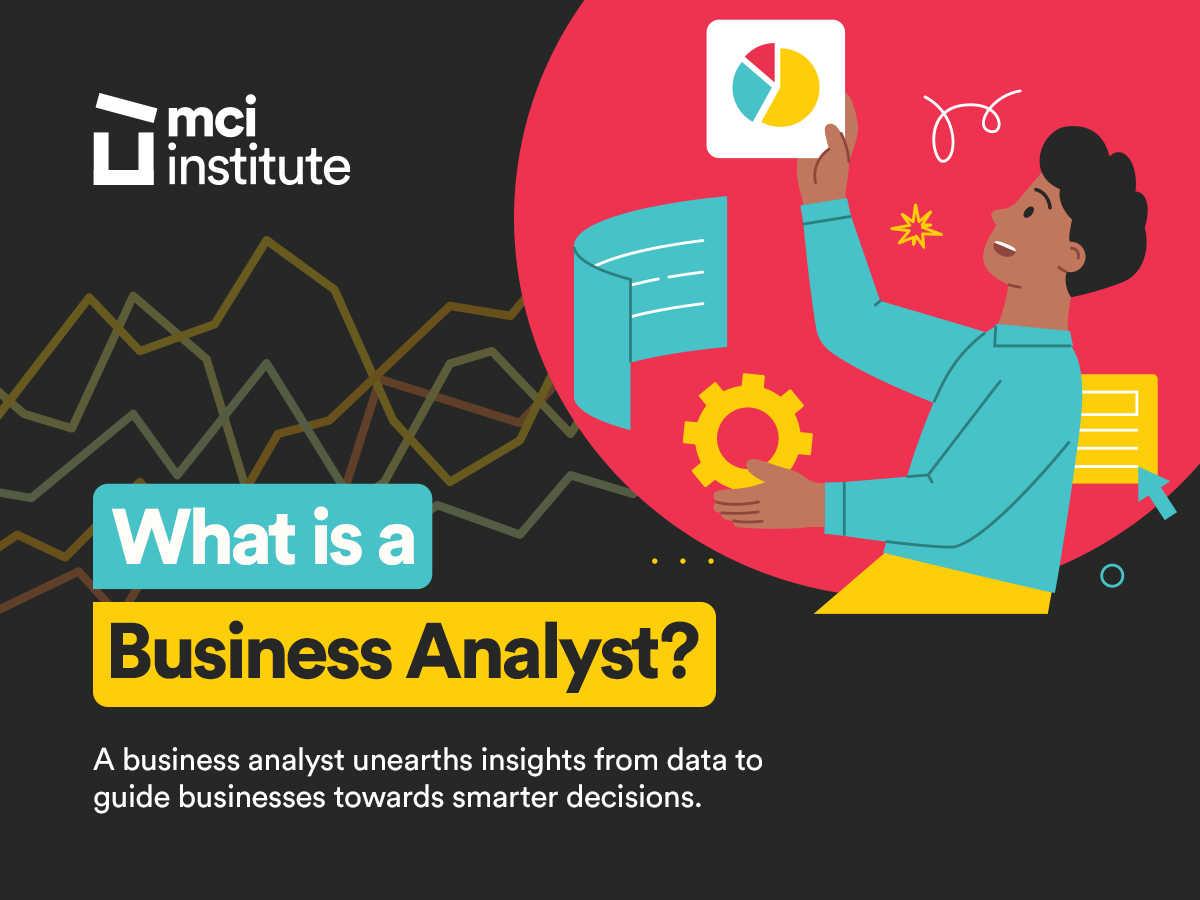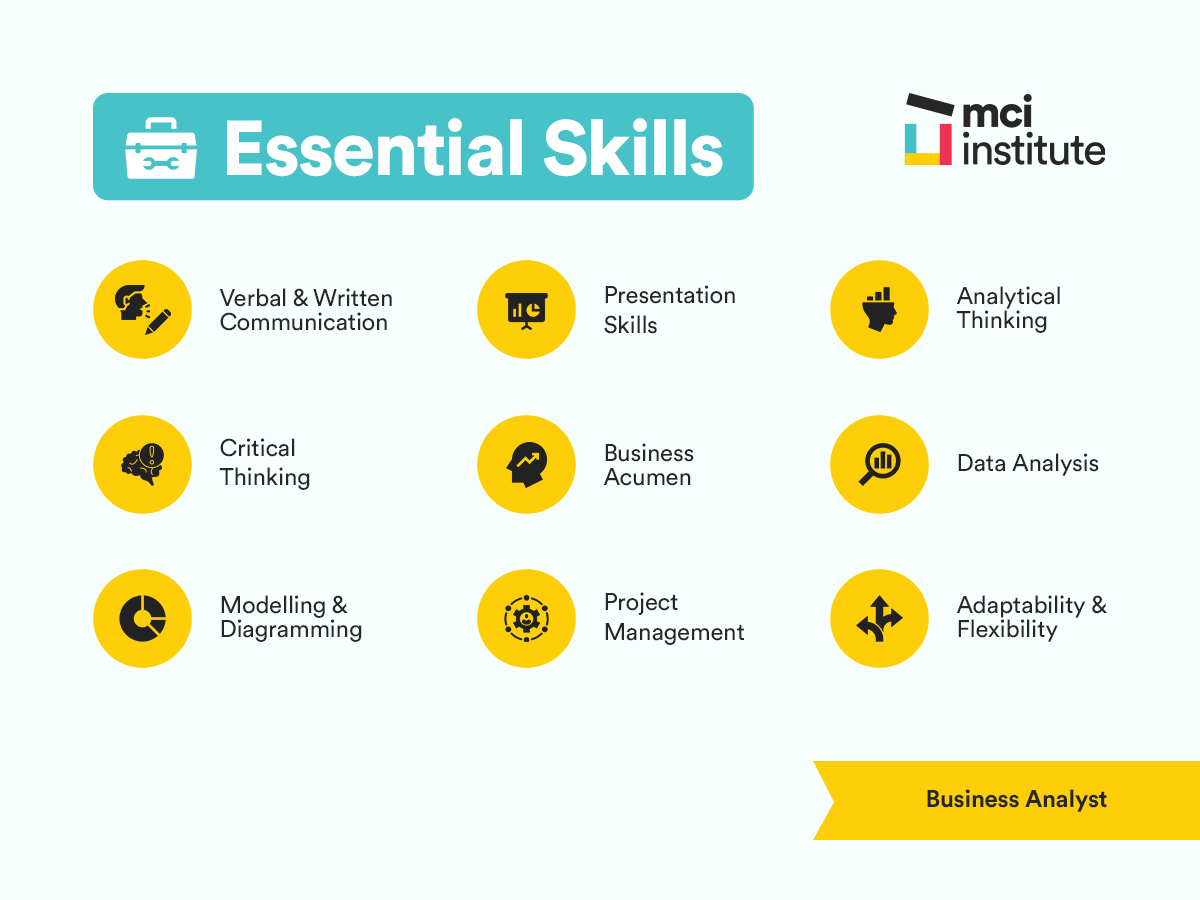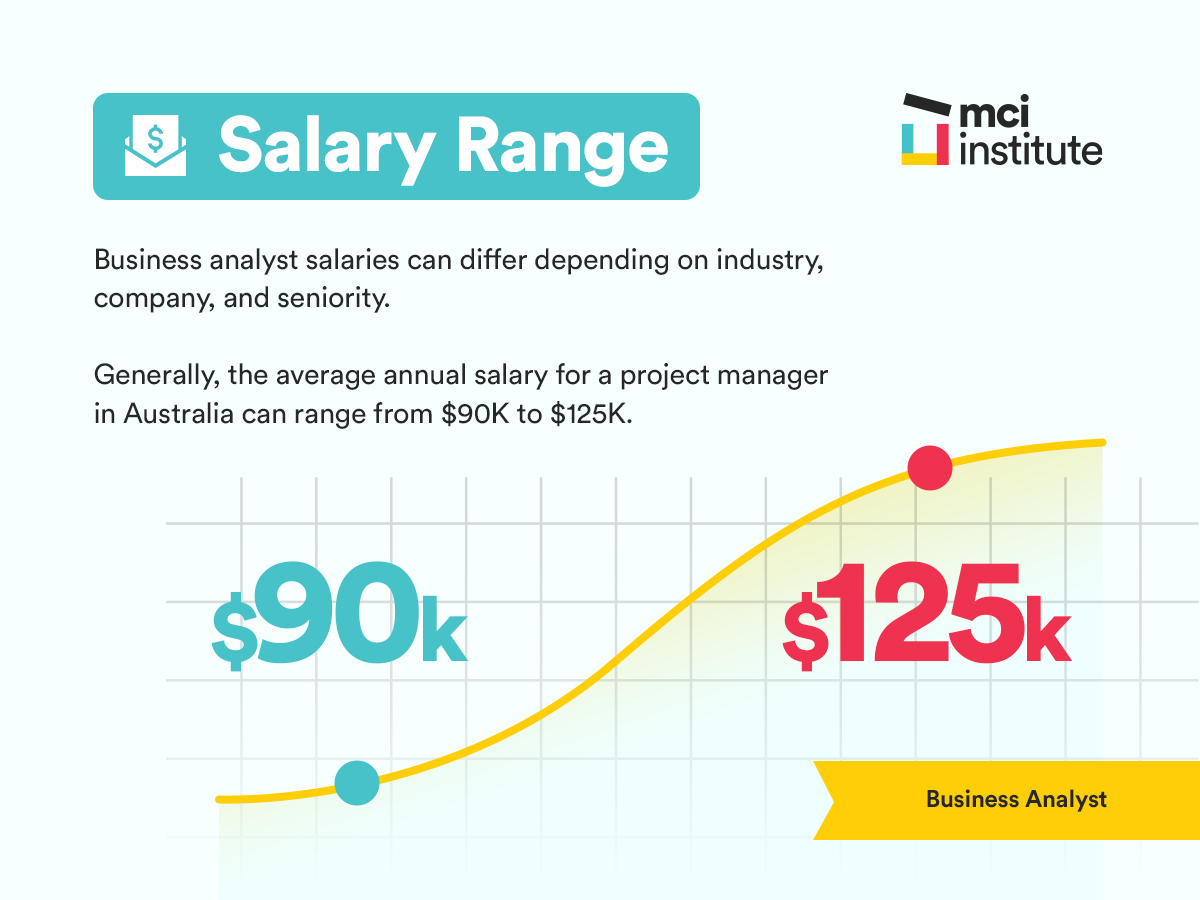Beyond the flashy headlines and boardroom decisions, there's a silent force helping to orchestrate it all: the business analysts.
They're the detectives of dysfunction, the problem-solving artists, the unsung heroes who diagnose problems, optimise processes, and make sure every cog in the machine fits and is working flawlessly.
Business analysts are the bridge between ideas and solutions. They analyse, strategise, and steer the business towards success.
Are you thinking about becoming a business analyst? Wondering what a business analyst actually does day-to-day? We'll break it down for you.
What is a business analyst?

A business analyst acts as a liaison between business stakeholders and the technical team. They delve into the intricacies of a company's operations and extract valuable insights from a sea of data.
Their mission? To decode the language of business needs and translate them into tangible technical solutions. With a keen eye for detail and a strategic mindset, they identify and articulate requirements, steer projects towards success, and drive transformative changes.
By bridging the gap between technical teams and business stakeholders, business analysts ensure that every solution sails smoothly from concept to reality, steering businesses towards efficiency and innovation.
Key responsibilities of a business analyst
A business analyst is a key player who combines expertise in data analytics, process optimisation, and stakeholder management. Their role involves interpreting complex data, improving business processes, and ensuring that technology solutions meet business needs.
Requirements gathering
Requirements Gathering is a key part of a business analyst role, serving as the cornerstone for all subsequent project activities. It involves working closely with stakeholders to understand and document their needs, expectations, and any constraints they may be facing so they can develop solutions that align with business needs.
Responsibilities include:
- Engaging with stakeholders
- Using a variety of elicitation techniques, including interviews, surveys, and workshops
- Determining the business's most important needs and prioritising effectively
- Clear and concise documentation
- Maintaining traceability and keeping accurate records
- Change management
Data analysis
This revolves around sifting through data to extract meaningful insights, turning numbers into narratives that guide business strategy. It's where analytical prowess meets business acumen, allowing analysts to pinpoint trends, identify patterns, and forecast future scenarios.
Responsibilities include:
- Data collection
- Statistical analysis
- Data interpretation
- Reporting
- Giving data-driven recommendations
- Predictive analysis
- Continuous monitoring
Process mapping
Visualisation is a big part of improving business processes, and process mapping allows analysts to create detailed flow charts or diagrams that illustrate how a process will flow from start to finish. On the way, they'll hopefully identify inefficiencies, redundancies, and opportunities.
Responsibilities include:
- Identifying processes that need mapping
- Detailed mapping
- Collaborating with stakeholders
- Bottleneck identification
- Process optimisation
- Documentation and communication
- Reviewing and updating
Solution evaluation
Review is a crucial part of being a business analyst. It's important to scrutinise and assess whether a proposed solution has been successful on an ongoing basis. This involves weighing up the pros and cons and determining overall effectiveness.
Responsibilities include:
- Solution assessment
- Incorporating stakeholder feedback
- Identifying potential risks
- Evaluating the expected benefits against the costs and resources required
- Scenario analysis
- Formulating well-informed recommendations
- Implementation strategy
Stakeholder engagement
Building and maintaining robust relationships with all relevant parties on a project is an important part of being a business analyst. This is more than just communication; it's about establishing trust, understanding diverse viewpoints, and making sure everyone's voice is heard and considered in the decision-making process.
Responsibilities include:
- Identifying stakeholders
- Communication planning
- Active listening and feedback
- Conflict resolution
- Engagement strategies
- Relationship building
Forecasting and planning
This involves analysing current data, market trends, and historical patterns to make educated guesses about the future, helping guide strategic decisions for the business. It's a proactive approach that blends analytics with visionary thinking.
Responsibilities include:
- Trend analysis
- Risk analysis
- Scenario planning
- Data-driven predictions
- Resource allocation
- Risk assessment
- Strategy development
Project management
Project management for a business analyst isn't just about spreadsheets and deadlines; it's about conducting the harmonious flow of a project from inception to completion. They play a big role in project planning, monitoring, and control.
Responsibilities include:
- Defining project timelines, milestones, and dependencies
- Estimating project costs, allocating resources, and tracking expenses
- Identifying potential risks, assessing impact, and implementing mitigation strategies
- Communicating with stakeholders
- Issue resolution and change management
Change management
Being the driving force for the implementation of new solutions often needs someone to manage this change. Business analysts can help communicate changes, address concerns, and train users.
Responsibilities include:
- Developing communication plans
- Addressing concerns and managing resistance
- Developing and delivering training
- Monitoring user adoption and providing ongoing support
Technology acumen
Understanding basic software development methodologies and technical concepts can be helpful for effective communication with developers and ensuring solutions are technically feasible.
Responsibilities include:
- Understanding software development lifecycles
- Technical requirements gathering
- System testing and validation
- Staying up-to-date with technological trends
Why become a business analyst?
Being a business analyst brings a host of benefits that can feel rewarding both professionally and personally. Here are just a handful.
- Shape the future of businesses, not just analyse it: business analysts aren't just number crunchers; they're architects of change, guiding companies towards innovation and success.
- Diverse career opportunities: you'll not only have opportunities in a range of industries but you'll also have opportunities to progress to senior roles, management positions, or even consulting... globally!
- High demand and job security: with continued digitalisation, businesses are becoming more and more data-driven, which means business analysts will be in demand and will likely enjoy job stability
- Play a central role in decision-making: through your data-driven insights, you'll have a direct impact on strategic decisions
- Opportunity for innovation: as a business analyst, you'll often lead the way in implementing new technologies and approaches to improve business efficiency
- Flexibility and autonomy: you'll generally be able to exercise a lot of independence in this role, with flexibility in work methods and decision-making
- Cross-company collaboration: you'll be working with a lot of different stakeholders across the company, which gives you the unique opportunity to learn from a wide range of people and job roles
- Develop a diverse skillset: hone your analytical, problem-solving, communication, and interpersonal skills, as well as technical expertise.
- Be the voice of the user: advocate for user needs and champion efficient, human-centred solutions.
- Combines soft and hard skills: thrive in a role that balances the analytical with the human touch. You'll need both logic and empathy.
Essential business analyst skills

Business analysts wear many hats. To excel in this dynamic field, you need to have a diverse set of essential skills. Here's a breakdown of some key areas.
Communication
- Verbal and written fluency: able to clearly explain complex concepts to both technical and non-technical audiences.
- Active listening: to understand stakeholder needs and requirements
- Presentation skills: able to present findings and recommendations persuasively
Analytical thinking
- Problem-solving: identify issues, analyse data, and propose solutions
- Critical thinking: evaluating information objectively and asking insightful questions
- Decision-making: making sound recommendations based on your evidence
Business acumen
- Understanding of business processes and industry trends
- Financial literacy: analysing costs and benefits of proposed solutions
- Knowledge of relevant regulations and compliance requirements
Technical skills
- Data analysis: using tools like SQL, Excel and Power BI to extract insights from data
- Modelling and diagramming: visualising and documenting business processes to identify areas for improvement
- Project management: planning, monitoring and controlling projects within budget and timelines
- Basic understanding of the software development lifecycle (SDLC)
Soft skills
- Interpersonal skills: building strong relationships with stakeholders at all levels
- Collaboration and teamwork: working effectively with diverse teams
- Adaptability and flexibility: embracing change and new challenges
Bonus skills
- Knowledge of your specific industry (e.g. healthcare, financial)
- Agile methodologies and UX design
- Storytelling and data visualisation skills
Pathways to becoming a business analyst
Get a formal qualification.
Consider an undergraduate degree in Business, Business Analytics, IT, or other related fields. If you already have a Bachelor's degree, you can look at postgraduate qualifications, like a Master's in Business Analytics.
Different Diploma and Certificate courses can also provide a good foundation for your business analyst skills, and open doors to some entry-level positions.
Get experience
Look for positions like junior analyst, data analyst, project coordinator, or customer support specialist. These roles can help you gain relevant experience and develop essential skills.
If you're already working in a similar field, you might be able to find internal opportunities to move into a business analyst role.
Volunteering and freelancing can also be a great way to build your portfolio and give you the experience you need to take the next step.
Conquer the BABOK guide
This international standard unlocks the core principles of business analysis. Familiarity boosts your creativity, prepares you for certifications, and empowers you to navigate the field with confidence.
Join the IIBA network
Tap into a community of fellow analysts. Access exclusive resources, find your career path through networking and mentorship, and gain an edge with discounted training and instury recognition.
Business analyst salary

As a business analyst, your salary may vary depending on the industry you work in, your company, or your seniority.
As a business analyst in Australia, you can generally expect to earn between $90K-$125K annually.
Business analyst resume tips
Tailoring your resume to the role you're applying for is always essential. If you're applying to business analyst roles, here are a few things you should keep in mind when crafting your resume.
- Showcase your analytical prowess. Dedicate a section to technical skills, and list any relevant tools and technologies you're proficient in. But don't just list - demonstrate. How have you used these skills to solve problems and analyse data?
- List your certifications. If you have any relevant ones, like Six Sigma or PMP, list them!
- Quantify your accomplishments. Instead of listing daily tasks, showcase the results and impact. Don't forget to use active voice!
- Focus on relevant experiences. Even if it's not directly as a business analyst, you can still highlight transferrable skills like project management, data analysis, and communication.
Business analyst interview questions
While you can't predict how an interview will go, you can put your best foot forward and prepare some answers to a few potential questions you might be asked. Here are just a handful, but keep in mind, this is just a guide! We encourage you to do your own research and preparation, too.
- How would you go about analysing a complex business process and identifying potential areas for improvement?
- Describe a time when you had to deal with conflicting stakeholder priorities. How did you handle it?
- Share an example of how you have used data analysis to solve a business problem.
- Give an example of how you used data visualisation to effectively communicate insights to stakeholders.
- How do you handle difficult conversations or disagreements with colleagues or clients?
Take the next step in your business analyst career
If you're ready to kickstart your career as a business analyst, or simply want to upskill for future success, our selection of online business management courses is a great first step. Explore our business courses and enrol today!
Excited to showcase the role of a business analyst on your website? Go ahead and embed this infographic with ease! Just copy and paste the HTML code provided below into your site's code, and you're all set to share this insightful visual with your audience.

.png?width=113&name=MCIinstitute_RGB_Color_Black-01%20(2).png)


